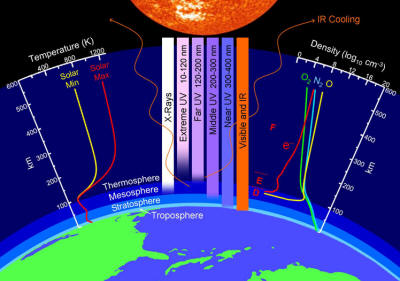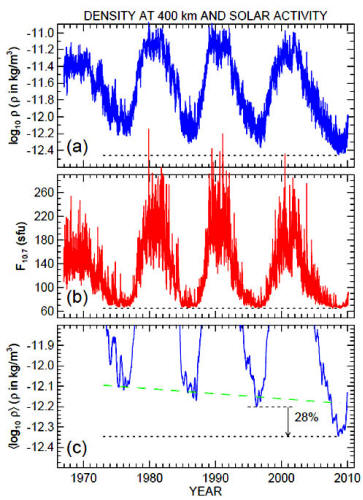|
July 15, 2010 from ScienceNASA Website
NASA-funded researchers are monitoring a big event in our planet's atmosphere.
High above Earth's surface where the atmosphere meets space, a rarefied layer of gas called "the thermosphere" recently collapsed and now is rebounding again.
Credit: John Emmert/NRL.
The collapse happened during the deep solar minimum of 2008-2009 - a fact which comes as little surprise to researchers.
The thermosphere always cools and contracts when solar activity is low. In this case, however, the magnitude of the collapse was two to three times greater than low solar activity could explain.
The thermosphere ranges in altitude from 90 km to 600+ km.
It is a realm of meteors, auroras and satellites, which skim through the thermosphere as they circle Earth. It is also where solar radiation makes first contact with our planet. The thermosphere intercepts extreme ultraviolet (EUV) photons from the sun before they can reach the ground. When solar activity is high, solar EUV warms the thermosphere, causing it to puff up like a marshmallow held over a camp fire. (This heating can raise temperatures as high as 1400 K - hence the name thermosphere.)
When solar activity is low, the opposite happens.
Researchers immediately turned their attention to the thermosphere to see what would happen.
How do you know what's happening all the
way up in the thermosphere?
He analyzed the decay rates of more than 5000 satellites ranging in altitude between 200 and 600 km and ranging in time between 1967 and 2010. This provided a unique space-time sampling of thermospheric density, temperature, and pressure covering almost the entire Space Age.
In this way he discovered that the thermospheric collapse of 2008-2009 was not only bigger than any previous collapse, but also bigger than the sun alone could explain.
One possible explanation is carbon dioxide (CO2).
but cools the upper
atmosphere. When carbon dioxide gets into the thermosphere, it acts as a coolant, shedding heat via infrared radiation. It is widely-known that CO2 levels have been increasing in Earth's atmosphere.
Extra CO2 in the thermosphere could have magnified the cooling action of solar minimum.
According to Emmert and colleagues, low solar EUV accounts for about 30% of the collapse. Extra CO2 accounts for at least another 10%.
That leaves as much as 60%
unaccounted for.
The overall sensitivity of the thermosphere to solar radiation could actually be increasing.
Or not.
Exactly how the recovery proceeds could unravel the contributions of solar vs. terrestrial sources.
|


